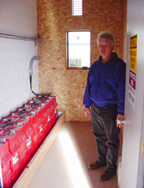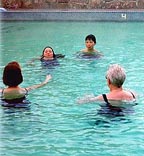Geothermal Success Stories
Geothermal Heat Keeps Resort in Vegetables, Flowers Year Around
History, tradition, beauty, education and fun are blossoming alongside sunflowers at Chico Hot Springs garden and geothermal greenhouse at Pray, Montana in the Paradise Valley. The folks at Chico strive to provide guests with a relaxing environment and memorable experiences, as well as fresh, delectable meals.
Chico has been welcoming guests for more than a hundred years. By the 1920s, a sizable five-acre garden provided much of the food served to hotel guests. Today, Chico staff carry on these traditions. The geothermally heated greenhouse, built in 1996, produces fresh herbs, flowers, and vegetables year around. Outdoors, a large vegetable garden produces a wide variety of fresh treats for guests. Dining room chefs demand high-quality, fresh foods with superior flavor. For that reason, gardeners use only organic methods of fertilization and pest control. Chico is starting a new tradition of sustainable agriculture as a means to provide guests with memories of good food in a gorgeous setting.
The resort also uses wastewater from the hot springs to heat offices and outlying buildings. Low-flow faucets and fixtures help reduce water use.
Gardener Lorraine Swift hopes to install a new geothermal system in the fall. "I would like to run the greenhouse's hot-water out-flow through tubing, warming two or three of the garden beds outside the greenhouse," she said "This, combined with cold frames, will allow us to grow and harvest cold-weather crops throughout the winter." To learn more about the operation, visit the Chico Hot Springs website.
Fairmont Taps Geothermal Resource to Reduce Heating Energy Costs
 Fairmont Hot Springs photo
Fairmont Hot Springs photo
Fairmont Hot Springs Fairmont Hot Springs, 15 miles west of Butte, is known throughout the Northwest for its generous pools. The resort, which is open year around, has two Olympic-size swimming pools and two soaking pools, one of each located indoors and outdoors. The pools are fed by a virtually unlimited supply of 157-degree natural hot springs water, cooled to various temperatures for comfort and enjoyment. The large indoor and outdoor pools are kept at between 89 and 92°F, while the smaller indoor and outdoor pools are kept between 100 and 105°F. A 350-foot enclosed waterslide also uses hot springs water to provide guests with a wet and wild ride into the outdoor pool.
Before 1984, Fairmont drew its hot water from artesian wells that bubbled out of the ground at 125°F. That water heated the building, with a gas booster for winter heat.
Water from the artesian wells still supplies the swimming and soaking pools. Another 600-foot well drilled in 1984 also supplies hot water to the facility. That well is fitted with a 50hp submersible pump that delivers water at 170°F at the rate of 150-180 gallons per minute. The water is pumped from the well house to the resort through a four-inch fiberglass pipe and deposited in a collection pit.
Some of that water is used to heat resort buildings directly. Return water from the system goes into a second collection pit, which in turn feeds the steam rooms and pools and preheats domestic hot water for the resort's showers, kitchen and laundry, providing an estimated savings of $5,000 a month in heating costs, according to Vern Cook, maintenance supervisor. Visit the Fairmont Hot Springs website.
Solar, Wind, Geothermal Power on Display at Spa Hot Springs
As much as he can, Gene Gudmundson takes advantage of solar, wind and geothermal energy at Spa Hot Springs Motel in White Sulphur Springs.

"We utilize all alternative energy sources available to us," Gudmundson says. "We believe in thinking globally and acting locally. We use our natural resources to provide your comfort, but we do it in a way that is not harmful to the environment. We strive to be a model of clean energy consumption and better business for the future."
That philosophy led Gudmundson to install a wind turbine and solar electric panels last December to meet some of his electricity needs.
The Whisper 175 wind turbine sits atop a 44-foot tower. The 3000-watt rated turbine delivers in excess of 500 kilowatt hours per month in a 12 mph wind. The Southwest Windpower machine has a 14-foot rotor diameter and features a handmade fiberglass and foam core blade for smooth, high-efficiency operation and low-wind start-up. It also incorporates a patented "angle governor" design for quiet operation in high winds. It has a peak power rating of 3200 watts at 27 mph.
According to Gudmundson, "the only sound you'll hear is when the wind is really pounding on it . and then only if you stand next to it."
The tower and turbine, installed by Sunelco of Hamilton, Montana, stand 100 feet or so from the spa and motel.
"You can hear it sometimes at night, but it's not an unpleasant sound," says Gudmundson "The only comments we've had from motel guests have all been positive."

Gudmundson's 16-panel solar electric system, also installed in December by Sunelco, includes two Kyocera 120-watt solar modules that produce 7.1 amps at 16.9 volts. Both arrays are mounted on Zomeworks racks that track the sun.
"It is kind of neat to watch the thing move and follow the sun," Gudmundson says.
The wind and solar systems are net metered, which allows them to feed excess electricity back into the utility grid. The two systems provide about a quarter of the Spa's electric power needs.
"We've got a very large electric load," Gudmundson says. The load includes lighting and appliances for a 21-room motel, pools and dressing rooms and Gudmundson's Hot Springs Natural Health Clinic and chiropractic office, which serves clients from all over.
At current rates of 6-7 cents a kilowatt hour, electric bills for the facility run between $600-$1,000 per month.

A bank of 12 batteries provides a backup system if the Spa loses power, which would be more than a mere inconvenience. If the power fails, and the pump stops working in the well, water builds up and flows onto the ground.
"Muddy water will flow back and foul our well," explains Gudmundson. "Now with a backup system, if the power goes - whether for a half hour or two hours - the battery system will circumvent that whole problem."
While the Spa uses the sun and wind to help generate electricity, it relies on hot water from geothermal wells to provide heat . and, of course, to replenish the Spa's pools, which are known worldwide for their ideal mineral content and soothing properties. The chemistry of the waters has frequently been praised and often compared to Baden-Baden, the famous spa in Germany.
"We like to say that the waters of Baden-Baden are almost, but not quite, as good as these," says Gudmundson.
Water flows from the ground at the Spa at 130 degrees. Gudmundson uses a system of heat exchangers to heat the rooms and domestic water. The system delivers water to the pool at 120 degrees.
With wind and solar added in, Gudmundson estimates that the Spa produces more than half of its energy using renewable resources.
"We're certainly one of a kind when we combine geothermal, solar and wind in a commercial facility like this," he says. "I'm certain nobody else does that, at least not to this degree."
To help finance the system, Gudmundson received a grant from the universal system benefits fund administered by Montana Power Company and paid for by all the utility's customers. The grant covered about a quarter of the total project cost of $40,000.
Despite a few glitches and delays in getting the system running, Gudmundson says he's pleased with the results.
"The pool ties in with the clinic, which ties in with the alternative energy stuff," he says. "It's all natural, healthy and non-polluting. They all tie in. They all complement one another."
Gudmundson says he's often asked why he chose to produce his own power since he's already drawing electricity from the utility at a relatively inexpensive rate.
"Is it economical? Do you mean within the first year or two? No," he says. "But I think it is economical in the long term because it is going to save electricity here this year, next year and the year after that." And, he adds, "Personally I like the aesthetics of it."
He likes the looks and other benefits so well, in fact, that he's already making plans to install additional solar panels and possibly another wind turbine.
"Our goal is to be completely self-sufficient with solar, wind and geothermal," he says. "And obviously as electricity prices go up, the payback becomes less."


